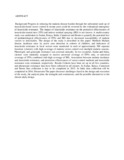| dc.description.abstract | Background
Progress in reducing the malaria disease burden through the substantial scale up of insecticide-based vector control in recent years could be reversed by the widespread emergence of insecticide resistance. The impact of insecticide resistance on the protective effectiveness of insecticide-treated nets (ITN) and indoor residual spraying (IRS) is not known. A multi-country study was undertaken in Sudan, Kenya, India, Cameroon and Benin to quantify the potential loss of epidemiological effectiveness of ITNs and IRS due to decreased susceptibility of malaria vectors to insecticides. The design of the study is described in this paper.
Methods
Malaria disease incidence rates by active case detection in cohorts of children, and indicators of insecticide resistance in local vectors were monitored in each of approximately 300 separate locations (clusters) with high coverage of malaria vector control over multiple malaria seasons. Phenotypic and genotypic resistance was assessed annually. In two countries, Sudan and India, clusters were randomly assigned to receive universal coverage of ITNs only, or universal coverage of ITNs combined with high coverage of IRS. Association between malaria incidence and insecticide resistance, and protective effectiveness of vector control methods and insecticide resistance were estimated, respectively.
Results
Cohorts have been set up in all five countries, and phenotypic resistance data have been collected in all clusters. In Sudan, Kenya, Cameroon and Benin data collection is due to be completed in 2015. In India data collection will be completed in 2016.
Discussion
The paper discusses challenges faced in the design and execution of the study, the analysis plan, the strengths and weaknesses, and the possible alternatives to the chosen study design. | en_US |

